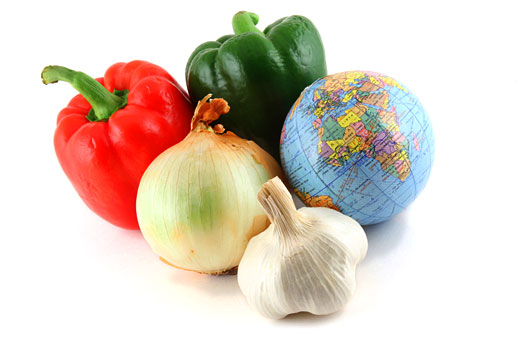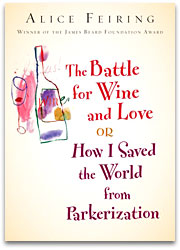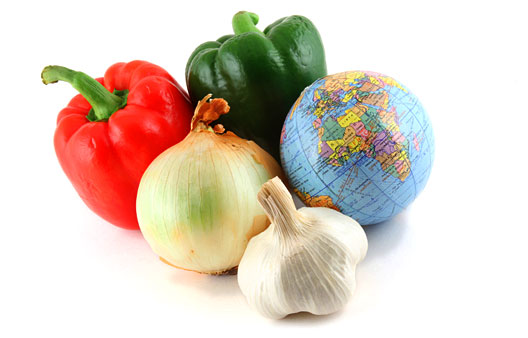
If you had to choose one place in the world to go for a summer break, where would it be?
For me, it would be a place I stayed once in Puglia, at the heel of Italy’s boot. In 2003, my friends and I spent a week at an agriturismo operation — a working organic olive farm that doubled as a kind of low-key rural hotel. Our quarters were in the cellar of a 17th century farmhouse, so during a heat wave that turned even the night into a cauldron, we rested as coolly as well-stored bottles of wine. Each day, we’d ride our bikes to a seaside town and hang out at the beach. Then we’d provision ourselves with fresh fish and produce and the area’s crisp, simple white wines, and bike back amid the olive groves to cook dinner.
Five years later, those idyllic memories seem like a fantasy. The euro has crushed the dollar since then, fuel costs have jacked up the price of long-distance travel, and heightened concern about climate change has made such voyages seem painfully frivolous. A vacation that we could barely afford then now lies out of reach.
But one can still dream, right? In that spirit, I’ve been immersing myself in three books that evoke those days and nights of wine, the sea, and Italy.
Grapes of Wrath
In The Battle for Wine and Love: Or How I Saved the World from Parkerization, Alice Feiring has written what might seem on the surface a frothy beach read. Largely a tale of sex and the city (OK, romance and the city — Feiring is too classy to dish the gory details), the book brims with chick-lit conventions. Feiring doesn’t identify her love interests with first names — instead, like Bridget and Carrie, she insists on calling them stuff like The Owl Man and Mr. Straight Laced. There’s a loose narrative line that I couldn’t quite keep up with involving love lost and regained. For me, Feiring strains mightily — and futilely — to link her affairs of the heart with her professional life as a wine writer.
On the other hand, who cares? Despite its fizzy packaging, this book packs a jolt. In many ways, it’s a noble old Burgundy hiding in a bottle labeled for a computer-programmed Australian Shiraz.
Don’t get that analogy? You will after reading Battle. Rising above the chick-lit chatter, the book emits a howl, bitter and impassioned, against the globalization of wine. According to Feiring, winemakers the world over have been using industrial-agriculture techniques — fertilizers, pesticides, heavy irrigation — to squeeze as much grape juice out of their land as possible. And they’ve been using all manner of newfangled techniques to manipulate that grape juice into wine that pleases the palates of a few highly influential critics.
Feiring’s bête noir is the eminent U.S. wine critic Robert Parker, who in the 1970s invented the now-ubiquitous 100-point scale for rating wine. For decades, Parker’s approval and florid descriptions (“sumptuous aromas of lead pencil shavings, crème de cassis, incense, black tea, flowers, and sweet cherries”) has wielded the power to make wine fly off shelves; his disapproval or indifference can send winemakers scrambling to hire consultants to help them “fix” their product. For Feiring, the influence of Parker and his imitator/competitors like the Wine Spectator has led to a homogenization of wine across the globe. Everyone from the makers of mass-market cheap stuff like Yellow Tail to prestige vintners in France and California strives to make big, fruity, aggressively oaked wines — the “jammy fruit bombs” favored by Parker.
Propelled forward by her chick-lit plotlines, Feiring tours us through some of the world’s most prestigious wine regions — France’s Rhone Valley, Burgundy, and Champagne; Spain’s Rioja; and Italy’s Piedmont — showing us how producers in each region have succumbed to “Parkerization,” subjecting their wines to biological (including the use of genetically modified yeast) and mechanical engineering to achieve the preferred flavor profile. She exposes egregious agricultural practices, too. Visiting the Moet Chandon vineyards in Champagne, Feiring observes that the soil “looked dead, with a cadaver-like grayness. Chemical weed killer had clearly been deployed instead of vineyard plows.”
But Feiring also seeks out and celebrates the holdouts in each region, the mavericks who ignore Parker’s palate and produce wines with minimal intervention. These wines deliver the elusive quality known as terroir, the sense of place in wine, a hint of the soil in the glass: the very thing blotted out by use of ultramodern winemaking techniques and industrial agriculture. If Parker lurks through the book like a villain, these makers of so-called “natural wine” emerge as its heroes.
With this book, Feiring probably hasn’t “saved the world from Parkerization,” but she has let loose a powerful punch at the forces of globalized, uniform wine. If The Battle for Wine and Love gains a fraction of the readers drawn to its literary models like Bridget Jones’ Diary, that punch might even connect. I endured the hackneyed literary gestures and learned much from this book — which left me thirsty for the simple, unpretentious white wines I enjoyed that summer in Puglia.
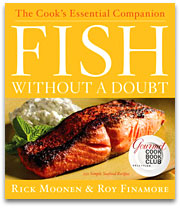
Fish Without a Doubt, by Rick Moonen.
Fishing in Vegas and Grilling with Mario
While Feiring celebrates terroir, chef Rick Moonen, author of Fish Without a Doubt, operates as if place matters little. In 2005, he transferred his celebrated seafood restaurant from its seaside perch in Manhattan all the way to Las Vegas, which bakes in the desert nearly 300 miles from the nearest coast.
But he’s a long-time proponent of sustainable seafood, and he’s written a valuable guide to cooking it. In the past 15 years, other great cooks have come out with magisterial guides to seafood, including Mark Bittman’s Fish and James Peterson’s Fish & Shellfish. Moonen commands a place on a crowded shelf with his streamlined, high-impact cooking style and his attention to the mounting troubles of the ocean.
“You won’t find monkfish, skate, red snapper, pompano, and other fish I love and would love to eat,” he writes in the introduction. “I’m holding off for the time when I can feel confident that these populations are strong again.” This is a book to get you excited about cooking within the bounds of Monterey Bay Aquarium’s Seafood Watch.
Beautifully put together and shot through with vivid photos, the book is organized into chapters on the major techniques of fish cookery: sautéing, grilling, broiling, etc. Moonen emphasizes technique and great raw materials over fussiness; few recipes go on longer than a page, and ingredient lists are short. While his recipes are simple and clear enough to engage novice cooks, the book also has much to teach someone like me, who’s been cooking seriously for years. In his one-page section on sautéing, for example, he suggests pressing down “lightly and evenly” on the filets with a spatula after they first hit the sizzling pan. I’ve always thought putting any pressure on delicate fish would be a disaster, squeezing out moisture. But when I tried it out with turbot filets, it was a triumph — the fish formed a beautiful, uniform brown crust and had melt-in-your-mouth texture.
Moonen’s also terrific at streamlining classic French touches. His red-wine butter sauce, for example, came together in minutes, required no difficult stock, and blanketed those turbot filets admirably. It’s always hard to say whether a new cookbook will end up collecting dust or kitchen splatters, but I suspect I’ll be reaching for Fish Without a Doubt for as long as I can justify buying fish.
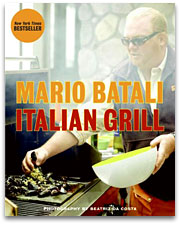
Itallian Grill, by Mario Batali.
Well, Moonen took me back to the sea, but not quite to Italy. To go there, I turned to that famous hedonist Mario Batali and his new book Italian Grill. Batali’s success as a restaurateur, cookbook writer, and TV personality rests on his ability to pack potent flavor into simple dishes. If you’re looking for restrained, studious takes on classical northern Italian cooking, look not to Batali but rather to Marcella Hazen. Batali has always known how to respect Italian cooking tradition while also kicking it in the pants: a lashing of chile pepper, a blunt blast of garlic, an aggressive squeeze of lemon.
This new book fits right into the Batali canon. Batali’s über-robust cooking style lends itself well to the grill; smoke and char add yet more force to his flavors. Like Moonen’s book, Italian Grill is a stunner to look at: Every recipe gets a dramatic full-page photo full of bright, sharp colors. As for recipes, everything is pretty straight-ahead. Winners I tried included shrimp coated in a salty rosemary-basil-breadcrumb mixture and then grilled, and a super-spicy dish featuring marinated zucchini grilled and then hit with not just dried chile-pepper flakes but also sliced serrano peppers. Fresh mint and crushed celery seeds balanced the fire of the chiles.
I won’t likely get back to Puglia anytime soon, but I can find provisions at a reputable fish monger, fire up the grill, and open a bottle of unmanipulated wine. As Proust showed with his madeleine, flavors can take us places even airplanes can’t. These three books are the travel agents for my time machine.
